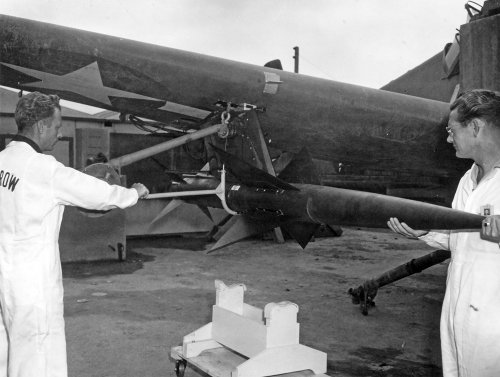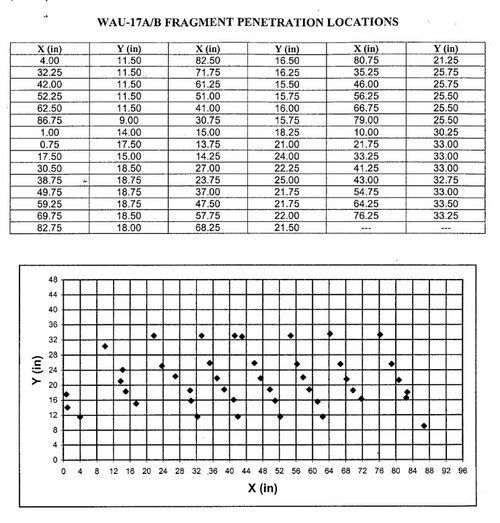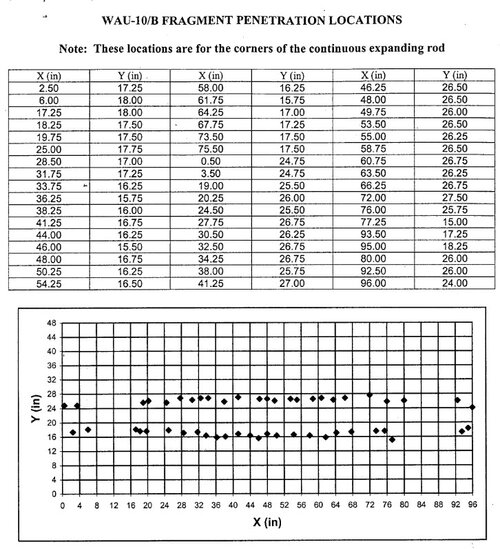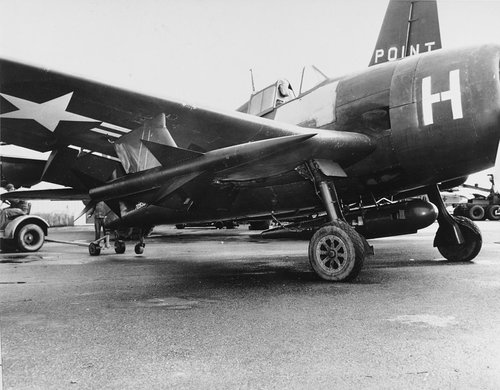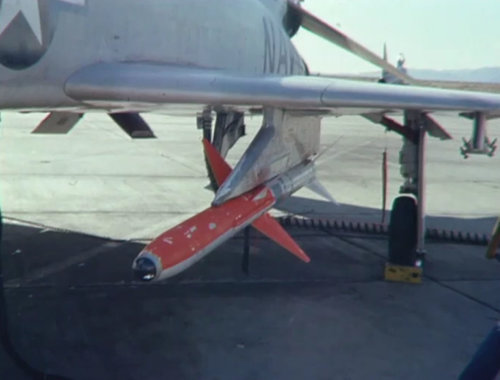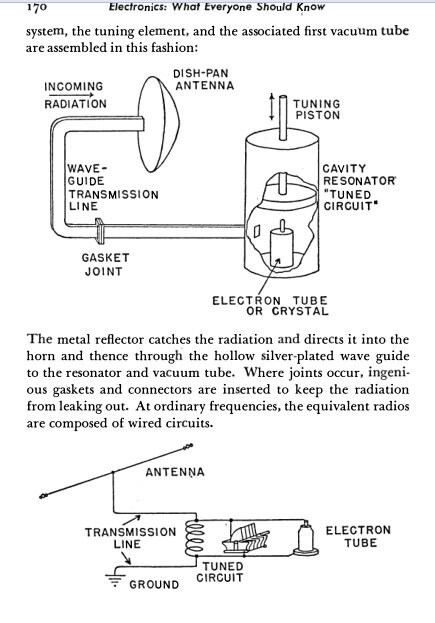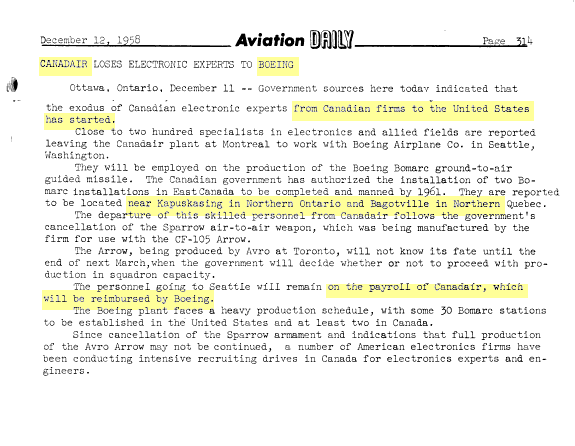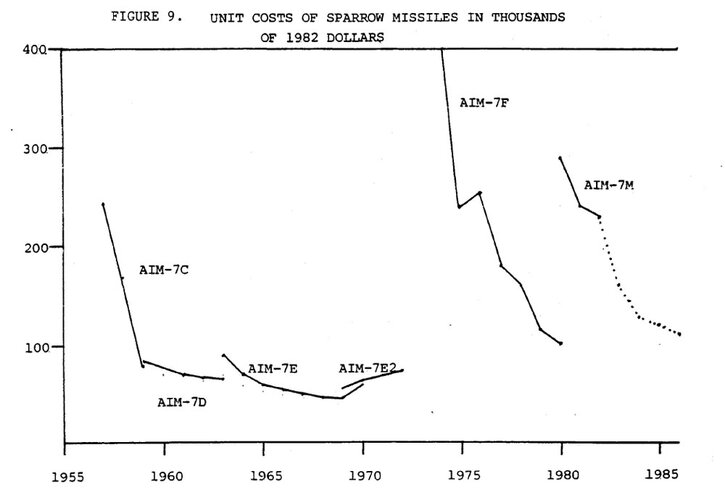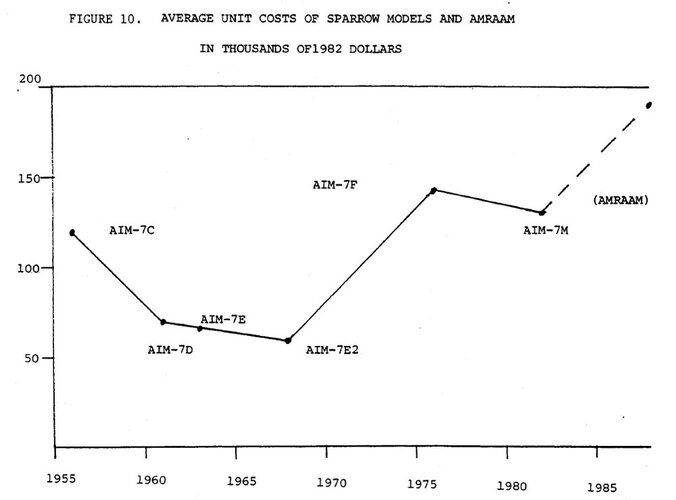- Joined
- 18 May 2019
- Messages
- 640
- Reaction score
- 1,673
The original Navy air-to-air missile program began near the end of World War II when BuAer advanced the concept of a beam-riding 5-in (13-cm) high-velocity aircraft rocket (HVAR). With this type of guidance system the launching aircraft illuminated the target with radar and the missile simply attempted to stay in the center of the radar beam. In May 1946, under Project Hot Shot, Sperry Gyroscope Co. of Bristol, TN, was asked to submit a proposal for a missile based on the HVAR with a range between 1,000 and 6,000 ft (305 and 1830 m) and fast enough to overtake a Mach 1.0 target.
The following March, Sperry reported that the HVAR's 5-in (13-cm) diameter was too small to accommodate the design requirements. An 8-in (20-cm) diameter missile body was recommended, a standard which was maintained for the entire Sparrow family. Douglas Aircraft Co. was subcontracted to produce the airframe while Sperry concentrated on guidance. The development contract was signed in May 1947, with project being named Sparrow in July. Unpowered separation testing began at Pt Mugu in January 1948.
In January 1951 the Navy placed an advance order for 1,000 Sparrow Is, officially designated air-to-air missile-Navy (AAM-N)-2. In September 1952 Sparrow became the first project of the newly established VX-4 of the Naval Air Missile Test Center at Pt Mugu CA.
In 1955, nearly 10 years after development began, VA-83, equipped with the F7U-3M Cutlass, became the first squadron to receive the new missile. Fleet service began in 1956 with deliveries to F3D-1M Skynight, F3H-2M Demon, and other F7U-3M squadrons. However, the 140-in (355-cm) long Sparrow I's beam-riding design lacked a true all-weather capability because its APG-51 guidance radar required visual identification of the target. Eventually, the entire concept was abandoned, with the last of 2,000 of the 310-lb Sparrow Is being delivered in April 1957. In 1962, after it was out of service, Sparrow I was redesignated AIM-7A.
The AAM-N-3 Sparrow II was another Douglas project, but featured a completely different guidance system with an active radar seeker. This increased the missile's length to 144 in (365 cm), which set the standard for all subsequent Sparrows. It was designed originally for the F5D Skylancer, but when that program was canceled in 1956 it was taken over by the Canadian government for their CF-105 Arrow, but that, too, was canceled in 1959. The 420-lb missile was belatedly redesignated AIM-7B in 1962.
The genesis of ultimate Raytheon 500-lb class AIM-7 Sparrow began in 1951 with their 380-lb AAM-N-6 Sparrow III. In reality, this was a completely new missile that featured SARH guidance behind a 'tangent ogive' radome, a 65-lb continuous-rod warhead, and a solid fuel rocket motor. The first guided launch occurred in February 1953, and it replaced the Sparrow I in production in 1956. (Although successfully tested in 1957, an infra-red guided version was canceled.) Reaching the fleet in August 1958, about 2,000 were produced to arm the F3H-2M Demon. The USAF had designated the Sparrow III as the AIM-101 prior to 1962, when the joint designation system redesignated it the AIM-7C.
The 440-lb AAM-N-6A Sparrow IIIA replaced the AAM-N-6 in production during 1959. It was the first Sparrow to supplement earlier rail launchers with an ejector launch capability. Its performance was increased by a limited proximity fuzing capability, enabling head-on intercepts, and a rocket motor which permitted supersonic launches and increased range. It was redesignated the AIM-7D in 1962, with 7,500 being produced to arm the F4H-1 and F-110A Phantom II.
The AIM-7E Sparrow IIIB entered production in 1963 and incorporated a new 7,600-lb thrust (33.81-kN), 2.9-second burn Mk 38 solid fuel rocket motor which resulted in a 75 percent range increase. The later Mk 52 motor was similar, but weighed 3 lb more, at 157 lb. Its DPN-72 GCS was composed of the CW-646 radome, OA-4137 target seeker, OA-4136 flight control group (/B through D/B versions), as well as the tunnel cable and waveguide.
Although it had a launch envelope of Mach 0.7 to 2.2, from sea level to 90,000 ft (27,430 m) at targets up to 13 miles (21 km) away, its utility in Vietnam was severely hampered by a minimum range of 1 mile (1.6 km). There, it to be virtually useless against maneuvering, fighter-sized targets, especially at low level.
The Italian Aspide missile used the AIM-7E as a jumping-off point. Work began in 1969 to incorporate an Italian SAR seeker to the Sparrow airframe. It is believed to have finally replaced the AIM-7E on Italian F-104Ss in the late 1980s. The AIM-7E-2 was an AIM-7E with the ALMC No. 27 'dogfight' modification, to give the missile a shorter minimum range (1,500 ft/457 m), as well as maneuverability and fuzing improvements. It was introduced in 1969 to correct AIM-7E performance shortcomings and was also exported to Britain for use with the F-4K/M. This version of the Sparrow was rushed to Southeast Asia where it replaced the AIM-7E within months.
Combat AIM-7Es were overall FSN 17925 gloss white, except for the radomes, which were left unpainted (a very light gray color). Color bands included a '1 to 3-in' wide FSN 23538 yellow band at the front of the warhead, and a '2 to 3-in' wide FSN 30117 brown band on the rocket motor beginning about three in behind the aft launch hook. The AIM-7E-2 (and
subsequent versions of the AIM-7E family) were identifiable by the 1-in wide FSN 17038 black 'L' markings on their wings.
All AIM-7E serial numbers were prefixed by 'R-' and suffixed by 'b'. This nomenclature was applied to both the target seeker and flight control sections. As a missile was upgraded, its suffix would reflect the version it had been upgraded to (e.g. R-8956-b would become R-8956-b-2 if it was upgraded by ALMC No. 27 to the AIM-7E-2 standard). Also, there were no leading zeros on the numbers applied to the missiles.
Finally, the table only reflects original production, not upgrades. All blocks beginning with the letter 'b' denoted AIM-7E-2 production. In the following table, the first suffix and last prefix in each sequence have been omitted. Of the 20,650 missiles built, 8653 (almost 42 per cent) were originally built as AIM-7E-2s. In FY65, the USAF allotted serials 65-995 to 2194 for AIM-7E production, but the order was canceled.
The AIM-7E-3 was an E-2 modified by AWC-78 (dated 27 August 1976), the 'reliability and fuze improvement modification'.
The AIM-7E-4 was an E-3 modified by AWC-93, also called the 'spillover modification', to allow it to be used with early F-14A Tomcats. Its DPN-85 GCS was composed of the CW-646 radome, OA-8888(V)2 target seeker, OA-8886(V)1 flight control group, as well as the tunnel cable and waveguide.
The RIM-7E-5 Sea Sparrow was a short-range self-defense weapon for ships that was used with the basic point defense surface missile system (BPDSMS). Unlike later RIM-7s, it had fixed wings. AIM-7E-2s were modified to RIM-7E-5 standard by AWC-78, Amendment 3 (dated 30 April 1979).
AIM-7E-3s were modified by AWC-78, Amendment 4 (beginning 30 April, further modified on 29 August 1979).
AIM-7E Components
Component/Nomenclature/Length/Weight/Remarks
Radome CW-646 19.24
Target Seeker OA-4137 23.63 CW
Flight Control OA-4136 37.39 155.7 weight for entire GCS
Wings (4) 2063-5147 37.4 16.00-in span, 18.62-in chord
Warhead Mk 38 Mod 0 12.99 69.4 expanding rod
Rocket Motor Mk 38 or Mk 52 50.72 157.0 various Mods
Fins (4) MX-4421 12.0 12.0-in span, 18.50-in chord
Miscellaneous 5.1 waveguides and tunnel cable
All Up Round AIM-7E 143.97 436.6
AIM-7E-2 Components
Component/Nomenclature/Length/Weight/Remarks
Radome CW-646 19.24
Target Seeker OA-4137A 23.63 CW
Flight Control OA-4136A or C 37.39 150.8 weight for entire GCS
Wings (4) 380031 34.4 16.00-in span, 18.62-in chord
Warhead Mk 38 Mod 0 12.99 69.4 expanding rod
Rocket Motor Mk 38 or Mk 52 50.72 157.0 various Mods
Fins (4) MX-4421 12.0 12.0-in span, 18.50-in chord
Miscellaneous 5.1 waveguides and tunnel cable
All Up Round AIM-7E-2 143.97 428.7
AIM-7E/E-2 Production
Block Serial Numbers Quantity Block Serial Numbers Quantity
af R-0001 to 0375-b 375 ax R-09521 to 10020-b 500
ag R-0376 to 0750-b 375 ay R-10021 to 10575-b 555
ah R-0751 to 1125-b 375 az R-10576 to 11259-b 684
ai R-1126 to 1500-b 375 ba R-11260 to 11733-b-2 474
aj R-1501 to 2250-b 750 ga R-11734 to 12135-b 402
ak R-2251 to 3000-b 750 gb R-12136 to 12219-b 84
al R-3001 to 3750-b 750 bb R-12220 to 12939-b-2 720
am R-3751 to 4350-b 600 bc R-12940 to 13352-b-2 413
an R-4351 to 5100-b 750 gc R-13353 to 13436-b 84
ao R-5101 to 5850-b 750 bd R-13437 to 13686-b-2 250
ap R-5851 to 6600-b 750 be R-13687 to 14616-b-2 930
aq R-6601 to 7350-b 750 bf R-14617 to 15546-b-2 930
ar R-7351 to 7550-b 200 bg R-15547 to 16476-b-2 930
as R-7551 to 7750-b 200 bh R-16477 to 17415-b-2 939
at R-7751 to 8355-b 605 gd R-17416 to 17455-b 40
au R-8356 to 8555-b 200 bi R-17456 to 18596-b-2 1141
av R-8556 to 8955-b 400 ge R-18597 to 18724-b 128
aw R-8956 to 9520-b 565 bj R-18725 to 20650-b-2 1926
AIM-7E-3 Components
Component/Nomenclature/Length/Weight/Remarks
Radome CW-646 19.24
Target Seeker OA-8887(V)1 23.63 CW
Flight Control OA-8886(V)1 37.39 150.8 weight for entire GCS
Wings (4) 595033 34.4 16.00-in span, 18.62-in chord
Warhead Mk 38 Mod 0 12.99 69.4 expanding rod
Rocket Motor Mk 38 or Mk 52 50.72 157.0 various Mods
Fins (4) MX-4421 12.0 12.0-in span, 18.50-in chord
Miscellaneous 5.1 waveguides and tunnel cable
All Up Round AIM-7E-3 143.97 428.7
AIM-7E-4 Components
Component/Nomenclature/Length/Weight/Remarks
Radome CW-646 19.24
Target Seeker OA-8888(V)2 23.63 CW
Flight Control OA-8886(V)1 37.39 150.8 weight for entire GCS
Wings (4) 595033 34.4 16.00-in span, 18.62-in chord
Warhead Mk 38 Mod 0 12.99 69.4 expanding rod
Rocket Motor Mk 38 or Mk 52 50.72 157.0 various Mods
Fins (4) MX-4421 12.0 12.0-in span, 18.50-in chord
Miscellaneous 5.1 waveguides and tunnel cable
All Up Round AIM-7E-4 143.97 428.7
RIM-7E-5 Components
Component/Nomenclature/Length/Weight/Remarks
Radome CW-646 19.24
Target Seeker OA-8887(V)2 23.63 CW
Flight Control OA-8886(V)2 37.39 150.8 weight for entire GCS
Wings (4) 2623601 34.4 16.00-in span, 18.62-in chord
Warhead Mk 38 Mod 0 12.99 69.4 expanding rod
Rocket Motor Mk 38 or Mk 52 50.72 157.0 various Mods
Fins (4) 2623602 12.0 12.0-in span, 18.50-in chord
Miscellaneous 5.1 waveguides and tunnel cable
All Up Round RIM-7E-5 143.97 428.7
AIM-7E-6 Components
Component/Nomenclature/Length/Weight/Remarks
Radome CW-646 19.24
Target Seeker OA-8888(V)2 23.63 CW
Flight Control OA-8886(V)1 37.39 158.8 weight for entire GCS
Wings (4) 595033 34.4 16.00-in span, 18.62-in chord
Warhead Mk 38 Mod 1 12.99 70.6 expanding rod
Rocket Motor Mk 38 or Mk 52 50.72 157.0 various Mods
Fins (4) MX-4421 12.0 12.0-in span, 18.50-in chord
Miscellaneous 5.1 waveguides and tunnel cable
All Up Round AIM-7E-6 143.97 437.9
The final 'E' was the AIM-7E-6, which incorporated the Mk 38 Mod 1 warhead as AWB 110, Rev. A. Over a period of 10 years 25,000 AIM-7Es, of various versions were produced at a unit cost of about $74,000, but none remain operational with the USAF or USN. Up to this point, the configuration of AIM-7s had been guidance and control section, wing, warhead, and rocket motor.
Work on the British XJ 521 Sky Flash began in 1972. It was essentially an AIM-7E-2 with an indigenous monopulse seeker and a new fuze, giving it performance similar to the AIM-7M's seeker against low-flying targets, but with the lower aerodynamic performance of the older missile. Sky Flash entered service with the RAF in 1979 on the F-4K/M and was also exported to Sweden where it entered service with JA 37 Viggens in 1981 as the Rb 71.
Also in 1981, production of the Tornado essential modification package (TEMP) Sky Flash began, with these missiles becoming basic equipment for the Tornado F.Mk 2/3. Continued improvement led to the 1985 introduction of the Super TEMP Sky Flash for both British and Saudi Tornado F.Mk 3s. These missiles featured modest aerodynamic changes for drag
reduction, an improved seeker, thinner wings, and a boost/sustain rocket motor. Beginning in 1988, earlier versions of Sky Flash were brought up to Super TEMP standards.
Development of a Thomson-CSF active seeker began in 1989, with a formal Active Sky Flash proposal being made to the RAF in January 1992. The original Swedish designation of this missile was Rb 71A when it was initially proposed, but changed to Rb 73 for a second proposal (for the JAS 39 Gripen).
Development the AIM-7F began in 1966, although it did not enter service until 1975. This virtually new missile used a CW-1178B/D 'von Karman' radome to cover the nose of the new OA-8877 target seeker section, which used either pulse-Doppler (PD) or continuous wave (CW) guidance and was designed to make the missile more capable against maneuvering,
low-altitude targets.
Avionics improvements enabled the primary WAU-10 continuous rod, or newer WAU-17 high explosive, blast-fragmentation warheads to be located in front of the OA-8878 flight control group, allowing the Mk 58 rocket motor to be enlarged (5,750-lb/25.6-kN 4.5-second boost, followed by 1,018-lb/4.5-kN 11-second sustainer), thus improving range. Four BSU-56 wings were attached to the flight control group, while BSU-57 fins were attached to the rocket motor.
The forward AIM-7F waveguide was 59.8 in (152 cm) long, while the aft was 61.5 in (156 cm) long. The missile had an 8.0-in (20-cm) diameter from the back of the radome to 8 in (20 cm) from the tail, when it tapered to a 6.6-in (17-cm) diameter. Production began in 1972 and ended in 1980, with the missiles costing about $276,000 each.
All missiles eventually went through a product optimization program (POP) retrofit, which was probably indicated by the AIM-7F-11 designation. AIM-7Fs were withdrawn from service by 1994 after being used to arm the F-4E/G/S, as well as the F-14, F-15, F-16ADF, and FA-18. The CATM-7F-3, also known as the Goldenbird airborne inert missile simulator (AIMS), was the captive trainer Sparrow for the AIM-7F, M, and P. The RIM-7F Sea Sparrow II was a version of the AIM-7F.
The AIM-7G was intended to arm the F-111D. However, it was canceled.
The RIM-7H-2 Sea Sparrow was developed from the AIM-7E-2 as a short-range self-defense weapon for ships. This was the first Sparrow fitted with folding wings and clipped fins (23.5-in/57-cm span). Its DPN-84A GCS was composed of the CW-646 radome, OA-4137B target seeker, OA-4136D flight control group, as well as the tunnel cable and waveguide.
It could be launched six seconds after commitment. After AWC-97 (the 'rapid runup' modification), if fitted with the proper wings and fins, it could be used as an air-to-air missile (although the reverse was not true of the AIM-7E-2).
The RIM-7H-5 was a RIM-7H-2 modified by AWC 78, Amendment 4-1 (dated 30 April 1979).
It was developed at the same time as the AIM-7E-4 for use with the NATO Sea Sparrow surface missile system (NSSMS). Its DPN-84B GCS was composed of the CW-646 radome, OA-8888(V)1 target seeker, OA-8886(V)1 flight control group, as well as the tunnel cable and waveguide. In addition to AWC-97, it incorporated parts of AWC-78.
AIM-7F Components
Component/Nomenclature/Length /Weight/Remarks
Radome CW-1178B/D 16.78 7.5 earlier versions 19.33-in long
Target Seeker OA-8877 26.84 57.51 PD/CW
Warhead WAU-10 15.76 85.6 expanding rod
Flight Control OA-8878 22.64 76.18
Wings (4) BSU-56A/B 38.8 16.00-in span, 17.66-in chord
Rocket Motor Mk 58 59.46 211.3 Mods 2, 3, and 5
Fins (4) BSU-57 24.6 11.5-in span, 18.5-in chord
Miscellaneous 6.62 waveguides and tunnel cable
All Up Round AIM-7F-11 141.48 508.11
RIM-7H-2 Components
Component/Nomenclature/Length/Weight/Remarks
Radome CW-646 19.24
Target Seeker OA-4137B 23.63 CW
Flight Control OA-4136D 37.39 150.8 weight for entire GCS
Rt. Wings (2) BSU-38 19.45 15.25-in span, 18.62-in chord
Left Wings (2) BSU-39 19.45 (23.3-in folded span)
Warhead Mk 38 Mod 0 12.99 69.4 expanding rod
Rocket Motor Mk 38 or Mk 52 50.72 157.0 various Mods
Fins (4) BSU-25 11.4 8.45-in span, 18.50-in chord
Miscellaneous 5.1 waveguides and tunnel cable
All Up Round RIM-7H-2 143.97 432.6
RIM-7H-5 Components
Component/Nomenclature/Length/Weight/Remarks
Radome CW-646 19.24
Target Seeker OA-8888(V)1 23.63 CW
Flight Control OA-8886(V)1 37.39 158.8 weight for entire GCS
Rt. Wings (2) BSU-38 19.45 15.25-in span, 18.62-in chord
Left Wings (2) BSU-39 19.45 (23.3-in folded span)
Warhead Mk 38 Mod 0 12.99 69.4 expanding rod
Rocket Motor Mk 38 or Mk 52 50.72 157.0 various Mods
Fins (4) BSU-25 11.4 8.45-in span, 18.50-in chord
Miscellaneous 5.1 waveguides and tunnel cable
All Up Round RIM-7H-5 143.97 440.6
AIM-7M Components
Component/Nomenclature/Length/Weight/Remarks
Radome CW-1178B/D 16.78 7.5
Guidance WGU-6 (early) 26.84 62.3 PD/CW
Warhead WAU-17 15.76 85.1 blast-fragmentation
Control WCU-5 22.64 72.0
Wings (4) BSU-56C/B 39.8 16.00-in span, 17.66-in chord
Rocket Motor Mk 58 59.46 211.3 Mods 2, 3, and 5
Fins (4) BSU-57 24.6 11.5-in span, 18.5-in chord
Miscellaneous 6.62 waveguides and tunnel cable
All Up Round AIM-7M 141.48 509.22
The 509-lb AIM-7M (F-1), featured an inverse monopulse seeker, active radar fuze, WAU-17 focused blast fragmentation warhead and numerous other evolutionary improvements to increase reliability and decrease cost (to $225,000 each). First produced by General Dynamics-Camden (Arkansas), it entered service in 1983, with production ending in 1992.
The WGU-5 GCS (A/B through E/B versions) was composed of the CW-1178B/D radome, WGU-6 guidance (A, B, or C/B versions), WCU-5 control sections (/B through D/B versions), as well as the tunnel cable and waveguide. To eliminate a wing-buzz problem discovered with the BSU-56A/B wings used by the AIM-7F, the AIM-7M's BSU-56C/B wings each had 0.25-lb weights affixed to their tips. The 510-lb AIM-7M (H-Build) missile featured GCS modifications including inertial observer guidance (IOG), improved ECCM, and a more sophisticated interface between the missile and its launch aircraft.
It could be distinguished from other AIM-7Ms by the 'H' suffix to its serial number. Aircraft equipped with AIM-7Ms included the F-14, F-15, and F/A-18.
The 502-lb RIM-7M was developed at the same time as the AIM-7M to replace the RIM-7F. It differed from the air-launched version by having 43.9-lb, BSU-64 folding wings, 12.4-lb, BSU-63 clipped fins (with 7.99-in/20-cm spans), and a 212.3-lb, Mk 58 Mod 4 remotely armed rocket motor. These missiles were used with the self-defense surface missile system (SDSMS), comprised of the Mk 57 NSSMS and the Mk 23 target acquisition system (TAS). They could also be used with the older Mk 41 and Mk 48 NSSMS.
The ATM-7M and RTM-7M were AIM/RIM-7M missiles with the warhead replaced by a AN/DKT-61 telemetry unit.
The 503-lb AIM-7P and RIM-7P missiles incorporated a new autopilot, computer, and fuze to improve the Sparrow's capability against cruise missiles. Initial flight testing ran from October 1989 through March 1991, with FOT&E conducted from July 1993 through March 1994.
Both modifications of AIM/RIM-7M, F1 and H-Build missiles and new missiles were procured. There were two types of modification kits: Block I, which incorporated new WGU-6D/B guidance section with the new DSU-34/B fuze (150 in FY91 and 390 in FY92), and Block II with WGU-6E/B guidance section, the same fuze, and a new rear antenna (474 in FY94 and 422 in FY95). Eventually all missiles will be brought up to Block II standards.
New missiles were built at a rate of 800 per year in both FY92 and FY93. AIM-7Ps were only used by the F-14 and F/A-18 (although they also underwent testing on the USAF's F-15). Its inverse monopulse seeker was compatible with either CW or pulse-Doppler illumination. The initial new production contract was released in June 1992, with Hughes-Tucson producing the largest share.
Eventually, all surviving USN AIM/RIM-7M missiles were upgraded to AIM/RIM-7P standards. These missiles were also offered to NATO countries, including in a vertical launch configuration. The ATM-7P and RTM-7P designations were assigned to identify AIM/RIM-7P missiles with the warhead replaced by a AN/DKT-61A telemetry unit.
The 514-lb AIM-7R and RIM-7R were only used only by the USN. A modification of Block II AIM-7Ps by the missile homing improvement program (MHIP), it incorporated a dual-mode high-speed missile infra-red (HSMIR) IR/SAR seeker. Infra-red guidance was provided by a nose-mounted seeker, only about half the size of that used by the AIM-9, but with a comparable performance. The IR terminal guidance was incorporated without compromising the performance of the existing SAR seeker.
After launch, the IR seeker was activated and its dome cover ejected. It then began a preprogrammed search pattern to lock onto the same target as the SAR seeker, whereupon the missile could transition to IR guidance, allowing the illuminating radar to break lock and engage a new target. If the transition to IR guidance did not occur (e.g. because equipment malfunction or bad weather), the missile could still be guided to the target using the illuminating radar. Initial flight testing was scheduled from October 1993 through September 1994, with FOT&E scheduled to begin in January 1996.
The 507-lb RIM-7R was developed as the same time as the AIM-7R. It was basically the same as the RIM-7P, but with the new seeker fitted.
The ATM-7R and RTM-7R designations were assigned to identify AIM/RIM-7P missiles with the warhead replaced by a AN/DKT-76 telemetry unit.
The first public disclosure of the operational use of a passively-guided version of the Sparrow (AIM-7R?) was made during the spring of 1994. One of these missiles, said to be fitted with either an infra-red or charge coupled device (CCD) TV seeker, reportedly shot down the first Iraqi aircraft of the 1991 Gulf War.
 OMG
OMG
The evolved Sea Sparrow missile (ESSM) was a virtually new missile, with a new airframe, bigger motor, and tail control. The ultimate program goal was a missile with a three-fold improvement in aerodynamic performance at twice the range of the RIM-7P.
Initial designations for ESSM are RIM-7PTC and RIM-7RTC (the TC standing for 'tail control'). It was also proposed as a replacement for the canceled AAAM Phoenix-replacement program.
Launchers included the AERO 7A (F-4 fuselage), LAU-17A (F-4 pylon), LAU-92 (F-14), LAU-106 (F-15), LAU-115 and -116 (F/A-18, and F-16).
AIM-7P Components
Component/Nomenclature/Length/Weight/Remarks
Radome CW-1178B/D 16.78 7.5
Guidance WGU-6 (late) 26.84 62.3
Warhead WAU-17 15.76 85.1 blast-fragmentation
Control WCU-5 22.64 72.0
Wings (4) BSU-56C/B 39.8 16.00-in span, 17.66-in chord
Rocket Motor Mk 58 59.46 211.3 Mods 2, 3, and 5
Fins (4) BSU-57 24.6 11.5-in span, 18.5-in chord
Miscellaneous 6.62 waveguides and tunnel cable
All Up Round AIM-7P 141.48 509.22
AIM-7R Components
Component/Nomenclature/Length/Weight/Remarks
Radome
Guidance 48.0 74.5 including radome
Warhead WAU-17 15.76 85.1 blast-fragmentation
Control WCU-5 22.64 72.0
Wings (4) BSU-56C/B 39.8 16.00-in span, 17.66-in chord
Rocket Motor Mk 58 59.46 211.3 Mods 2, 3, and 5
Fins (4) BSU-57 24.6 11.5-in span, 18.5-in chord
Miscellaneous 6.62 waveguides and tunnel cable
All Up Round AIM-7R 145.86 513.92
combat score of AIM-7R any information?
The following March, Sperry reported that the HVAR's 5-in (13-cm) diameter was too small to accommodate the design requirements. An 8-in (20-cm) diameter missile body was recommended, a standard which was maintained for the entire Sparrow family. Douglas Aircraft Co. was subcontracted to produce the airframe while Sperry concentrated on guidance. The development contract was signed in May 1947, with project being named Sparrow in July. Unpowered separation testing began at Pt Mugu in January 1948.
In January 1951 the Navy placed an advance order for 1,000 Sparrow Is, officially designated air-to-air missile-Navy (AAM-N)-2. In September 1952 Sparrow became the first project of the newly established VX-4 of the Naval Air Missile Test Center at Pt Mugu CA.
In 1955, nearly 10 years after development began, VA-83, equipped with the F7U-3M Cutlass, became the first squadron to receive the new missile. Fleet service began in 1956 with deliveries to F3D-1M Skynight, F3H-2M Demon, and other F7U-3M squadrons. However, the 140-in (355-cm) long Sparrow I's beam-riding design lacked a true all-weather capability because its APG-51 guidance radar required visual identification of the target. Eventually, the entire concept was abandoned, with the last of 2,000 of the 310-lb Sparrow Is being delivered in April 1957. In 1962, after it was out of service, Sparrow I was redesignated AIM-7A.
The AAM-N-3 Sparrow II was another Douglas project, but featured a completely different guidance system with an active radar seeker. This increased the missile's length to 144 in (365 cm), which set the standard for all subsequent Sparrows. It was designed originally for the F5D Skylancer, but when that program was canceled in 1956 it was taken over by the Canadian government for their CF-105 Arrow, but that, too, was canceled in 1959. The 420-lb missile was belatedly redesignated AIM-7B in 1962.
The genesis of ultimate Raytheon 500-lb class AIM-7 Sparrow began in 1951 with their 380-lb AAM-N-6 Sparrow III. In reality, this was a completely new missile that featured SARH guidance behind a 'tangent ogive' radome, a 65-lb continuous-rod warhead, and a solid fuel rocket motor. The first guided launch occurred in February 1953, and it replaced the Sparrow I in production in 1956. (Although successfully tested in 1957, an infra-red guided version was canceled.) Reaching the fleet in August 1958, about 2,000 were produced to arm the F3H-2M Demon. The USAF had designated the Sparrow III as the AIM-101 prior to 1962, when the joint designation system redesignated it the AIM-7C.
The 440-lb AAM-N-6A Sparrow IIIA replaced the AAM-N-6 in production during 1959. It was the first Sparrow to supplement earlier rail launchers with an ejector launch capability. Its performance was increased by a limited proximity fuzing capability, enabling head-on intercepts, and a rocket motor which permitted supersonic launches and increased range. It was redesignated the AIM-7D in 1962, with 7,500 being produced to arm the F4H-1 and F-110A Phantom II.
The AIM-7E Sparrow IIIB entered production in 1963 and incorporated a new 7,600-lb thrust (33.81-kN), 2.9-second burn Mk 38 solid fuel rocket motor which resulted in a 75 percent range increase. The later Mk 52 motor was similar, but weighed 3 lb more, at 157 lb. Its DPN-72 GCS was composed of the CW-646 radome, OA-4137 target seeker, OA-4136 flight control group (/B through D/B versions), as well as the tunnel cable and waveguide.
Although it had a launch envelope of Mach 0.7 to 2.2, from sea level to 90,000 ft (27,430 m) at targets up to 13 miles (21 km) away, its utility in Vietnam was severely hampered by a minimum range of 1 mile (1.6 km). There, it to be virtually useless against maneuvering, fighter-sized targets, especially at low level.
The Italian Aspide missile used the AIM-7E as a jumping-off point. Work began in 1969 to incorporate an Italian SAR seeker to the Sparrow airframe. It is believed to have finally replaced the AIM-7E on Italian F-104Ss in the late 1980s. The AIM-7E-2 was an AIM-7E with the ALMC No. 27 'dogfight' modification, to give the missile a shorter minimum range (1,500 ft/457 m), as well as maneuverability and fuzing improvements. It was introduced in 1969 to correct AIM-7E performance shortcomings and was also exported to Britain for use with the F-4K/M. This version of the Sparrow was rushed to Southeast Asia where it replaced the AIM-7E within months.
Combat AIM-7Es were overall FSN 17925 gloss white, except for the radomes, which were left unpainted (a very light gray color). Color bands included a '1 to 3-in' wide FSN 23538 yellow band at the front of the warhead, and a '2 to 3-in' wide FSN 30117 brown band on the rocket motor beginning about three in behind the aft launch hook. The AIM-7E-2 (and
subsequent versions of the AIM-7E family) were identifiable by the 1-in wide FSN 17038 black 'L' markings on their wings.
All AIM-7E serial numbers were prefixed by 'R-' and suffixed by 'b'. This nomenclature was applied to both the target seeker and flight control sections. As a missile was upgraded, its suffix would reflect the version it had been upgraded to (e.g. R-8956-b would become R-8956-b-2 if it was upgraded by ALMC No. 27 to the AIM-7E-2 standard). Also, there were no leading zeros on the numbers applied to the missiles.
Finally, the table only reflects original production, not upgrades. All blocks beginning with the letter 'b' denoted AIM-7E-2 production. In the following table, the first suffix and last prefix in each sequence have been omitted. Of the 20,650 missiles built, 8653 (almost 42 per cent) were originally built as AIM-7E-2s. In FY65, the USAF allotted serials 65-995 to 2194 for AIM-7E production, but the order was canceled.
The AIM-7E-3 was an E-2 modified by AWC-78 (dated 27 August 1976), the 'reliability and fuze improvement modification'.
The AIM-7E-4 was an E-3 modified by AWC-93, also called the 'spillover modification', to allow it to be used with early F-14A Tomcats. Its DPN-85 GCS was composed of the CW-646 radome, OA-8888(V)2 target seeker, OA-8886(V)1 flight control group, as well as the tunnel cable and waveguide.
The RIM-7E-5 Sea Sparrow was a short-range self-defense weapon for ships that was used with the basic point defense surface missile system (BPDSMS). Unlike later RIM-7s, it had fixed wings. AIM-7E-2s were modified to RIM-7E-5 standard by AWC-78, Amendment 3 (dated 30 April 1979).
AIM-7E-3s were modified by AWC-78, Amendment 4 (beginning 30 April, further modified on 29 August 1979).
AIM-7E Components
Component/Nomenclature/Length/Weight/Remarks
Radome CW-646 19.24
Target Seeker OA-4137 23.63 CW
Flight Control OA-4136 37.39 155.7 weight for entire GCS
Wings (4) 2063-5147 37.4 16.00-in span, 18.62-in chord
Warhead Mk 38 Mod 0 12.99 69.4 expanding rod
Rocket Motor Mk 38 or Mk 52 50.72 157.0 various Mods
Fins (4) MX-4421 12.0 12.0-in span, 18.50-in chord
Miscellaneous 5.1 waveguides and tunnel cable
All Up Round AIM-7E 143.97 436.6
AIM-7E-2 Components
Component/Nomenclature/Length/Weight/Remarks
Radome CW-646 19.24
Target Seeker OA-4137A 23.63 CW
Flight Control OA-4136A or C 37.39 150.8 weight for entire GCS
Wings (4) 380031 34.4 16.00-in span, 18.62-in chord
Warhead Mk 38 Mod 0 12.99 69.4 expanding rod
Rocket Motor Mk 38 or Mk 52 50.72 157.0 various Mods
Fins (4) MX-4421 12.0 12.0-in span, 18.50-in chord
Miscellaneous 5.1 waveguides and tunnel cable
All Up Round AIM-7E-2 143.97 428.7
AIM-7E/E-2 Production
Block Serial Numbers Quantity Block Serial Numbers Quantity
af R-0001 to 0375-b 375 ax R-09521 to 10020-b 500
ag R-0376 to 0750-b 375 ay R-10021 to 10575-b 555
ah R-0751 to 1125-b 375 az R-10576 to 11259-b 684
ai R-1126 to 1500-b 375 ba R-11260 to 11733-b-2 474
aj R-1501 to 2250-b 750 ga R-11734 to 12135-b 402
ak R-2251 to 3000-b 750 gb R-12136 to 12219-b 84
al R-3001 to 3750-b 750 bb R-12220 to 12939-b-2 720
am R-3751 to 4350-b 600 bc R-12940 to 13352-b-2 413
an R-4351 to 5100-b 750 gc R-13353 to 13436-b 84
ao R-5101 to 5850-b 750 bd R-13437 to 13686-b-2 250
ap R-5851 to 6600-b 750 be R-13687 to 14616-b-2 930
aq R-6601 to 7350-b 750 bf R-14617 to 15546-b-2 930
ar R-7351 to 7550-b 200 bg R-15547 to 16476-b-2 930
as R-7551 to 7750-b 200 bh R-16477 to 17415-b-2 939
at R-7751 to 8355-b 605 gd R-17416 to 17455-b 40
au R-8356 to 8555-b 200 bi R-17456 to 18596-b-2 1141
av R-8556 to 8955-b 400 ge R-18597 to 18724-b 128
aw R-8956 to 9520-b 565 bj R-18725 to 20650-b-2 1926
AIM-7E-3 Components
Component/Nomenclature/Length/Weight/Remarks
Radome CW-646 19.24
Target Seeker OA-8887(V)1 23.63 CW
Flight Control OA-8886(V)1 37.39 150.8 weight for entire GCS
Wings (4) 595033 34.4 16.00-in span, 18.62-in chord
Warhead Mk 38 Mod 0 12.99 69.4 expanding rod
Rocket Motor Mk 38 or Mk 52 50.72 157.0 various Mods
Fins (4) MX-4421 12.0 12.0-in span, 18.50-in chord
Miscellaneous 5.1 waveguides and tunnel cable
All Up Round AIM-7E-3 143.97 428.7
AIM-7E-4 Components
Component/Nomenclature/Length/Weight/Remarks
Radome CW-646 19.24
Target Seeker OA-8888(V)2 23.63 CW
Flight Control OA-8886(V)1 37.39 150.8 weight for entire GCS
Wings (4) 595033 34.4 16.00-in span, 18.62-in chord
Warhead Mk 38 Mod 0 12.99 69.4 expanding rod
Rocket Motor Mk 38 or Mk 52 50.72 157.0 various Mods
Fins (4) MX-4421 12.0 12.0-in span, 18.50-in chord
Miscellaneous 5.1 waveguides and tunnel cable
All Up Round AIM-7E-4 143.97 428.7
RIM-7E-5 Components
Component/Nomenclature/Length/Weight/Remarks
Radome CW-646 19.24
Target Seeker OA-8887(V)2 23.63 CW
Flight Control OA-8886(V)2 37.39 150.8 weight for entire GCS
Wings (4) 2623601 34.4 16.00-in span, 18.62-in chord
Warhead Mk 38 Mod 0 12.99 69.4 expanding rod
Rocket Motor Mk 38 or Mk 52 50.72 157.0 various Mods
Fins (4) 2623602 12.0 12.0-in span, 18.50-in chord
Miscellaneous 5.1 waveguides and tunnel cable
All Up Round RIM-7E-5 143.97 428.7
AIM-7E-6 Components
Component/Nomenclature/Length/Weight/Remarks
Radome CW-646 19.24
Target Seeker OA-8888(V)2 23.63 CW
Flight Control OA-8886(V)1 37.39 158.8 weight for entire GCS
Wings (4) 595033 34.4 16.00-in span, 18.62-in chord
Warhead Mk 38 Mod 1 12.99 70.6 expanding rod
Rocket Motor Mk 38 or Mk 52 50.72 157.0 various Mods
Fins (4) MX-4421 12.0 12.0-in span, 18.50-in chord
Miscellaneous 5.1 waveguides and tunnel cable
All Up Round AIM-7E-6 143.97 437.9
The final 'E' was the AIM-7E-6, which incorporated the Mk 38 Mod 1 warhead as AWB 110, Rev. A. Over a period of 10 years 25,000 AIM-7Es, of various versions were produced at a unit cost of about $74,000, but none remain operational with the USAF or USN. Up to this point, the configuration of AIM-7s had been guidance and control section, wing, warhead, and rocket motor.
Work on the British XJ 521 Sky Flash began in 1972. It was essentially an AIM-7E-2 with an indigenous monopulse seeker and a new fuze, giving it performance similar to the AIM-7M's seeker against low-flying targets, but with the lower aerodynamic performance of the older missile. Sky Flash entered service with the RAF in 1979 on the F-4K/M and was also exported to Sweden where it entered service with JA 37 Viggens in 1981 as the Rb 71.
Also in 1981, production of the Tornado essential modification package (TEMP) Sky Flash began, with these missiles becoming basic equipment for the Tornado F.Mk 2/3. Continued improvement led to the 1985 introduction of the Super TEMP Sky Flash for both British and Saudi Tornado F.Mk 3s. These missiles featured modest aerodynamic changes for drag
reduction, an improved seeker, thinner wings, and a boost/sustain rocket motor. Beginning in 1988, earlier versions of Sky Flash were brought up to Super TEMP standards.
Development of a Thomson-CSF active seeker began in 1989, with a formal Active Sky Flash proposal being made to the RAF in January 1992. The original Swedish designation of this missile was Rb 71A when it was initially proposed, but changed to Rb 73 for a second proposal (for the JAS 39 Gripen).
Development the AIM-7F began in 1966, although it did not enter service until 1975. This virtually new missile used a CW-1178B/D 'von Karman' radome to cover the nose of the new OA-8877 target seeker section, which used either pulse-Doppler (PD) or continuous wave (CW) guidance and was designed to make the missile more capable against maneuvering,
low-altitude targets.
Avionics improvements enabled the primary WAU-10 continuous rod, or newer WAU-17 high explosive, blast-fragmentation warheads to be located in front of the OA-8878 flight control group, allowing the Mk 58 rocket motor to be enlarged (5,750-lb/25.6-kN 4.5-second boost, followed by 1,018-lb/4.5-kN 11-second sustainer), thus improving range. Four BSU-56 wings were attached to the flight control group, while BSU-57 fins were attached to the rocket motor.
The forward AIM-7F waveguide was 59.8 in (152 cm) long, while the aft was 61.5 in (156 cm) long. The missile had an 8.0-in (20-cm) diameter from the back of the radome to 8 in (20 cm) from the tail, when it tapered to a 6.6-in (17-cm) diameter. Production began in 1972 and ended in 1980, with the missiles costing about $276,000 each.
All missiles eventually went through a product optimization program (POP) retrofit, which was probably indicated by the AIM-7F-11 designation. AIM-7Fs were withdrawn from service by 1994 after being used to arm the F-4E/G/S, as well as the F-14, F-15, F-16ADF, and FA-18. The CATM-7F-3, also known as the Goldenbird airborne inert missile simulator (AIMS), was the captive trainer Sparrow for the AIM-7F, M, and P. The RIM-7F Sea Sparrow II was a version of the AIM-7F.
The AIM-7G was intended to arm the F-111D. However, it was canceled.
The RIM-7H-2 Sea Sparrow was developed from the AIM-7E-2 as a short-range self-defense weapon for ships. This was the first Sparrow fitted with folding wings and clipped fins (23.5-in/57-cm span). Its DPN-84A GCS was composed of the CW-646 radome, OA-4137B target seeker, OA-4136D flight control group, as well as the tunnel cable and waveguide.
It could be launched six seconds after commitment. After AWC-97 (the 'rapid runup' modification), if fitted with the proper wings and fins, it could be used as an air-to-air missile (although the reverse was not true of the AIM-7E-2).
The RIM-7H-5 was a RIM-7H-2 modified by AWC 78, Amendment 4-1 (dated 30 April 1979).
It was developed at the same time as the AIM-7E-4 for use with the NATO Sea Sparrow surface missile system (NSSMS). Its DPN-84B GCS was composed of the CW-646 radome, OA-8888(V)1 target seeker, OA-8886(V)1 flight control group, as well as the tunnel cable and waveguide. In addition to AWC-97, it incorporated parts of AWC-78.
AIM-7F Components
Component/Nomenclature/Length /Weight/Remarks
Radome CW-1178B/D 16.78 7.5 earlier versions 19.33-in long
Target Seeker OA-8877 26.84 57.51 PD/CW
Warhead WAU-10 15.76 85.6 expanding rod
Flight Control OA-8878 22.64 76.18
Wings (4) BSU-56A/B 38.8 16.00-in span, 17.66-in chord
Rocket Motor Mk 58 59.46 211.3 Mods 2, 3, and 5
Fins (4) BSU-57 24.6 11.5-in span, 18.5-in chord
Miscellaneous 6.62 waveguides and tunnel cable
All Up Round AIM-7F-11 141.48 508.11
RIM-7H-2 Components
Component/Nomenclature/Length/Weight/Remarks
Radome CW-646 19.24
Target Seeker OA-4137B 23.63 CW
Flight Control OA-4136D 37.39 150.8 weight for entire GCS
Rt. Wings (2) BSU-38 19.45 15.25-in span, 18.62-in chord
Left Wings (2) BSU-39 19.45 (23.3-in folded span)
Warhead Mk 38 Mod 0 12.99 69.4 expanding rod
Rocket Motor Mk 38 or Mk 52 50.72 157.0 various Mods
Fins (4) BSU-25 11.4 8.45-in span, 18.50-in chord
Miscellaneous 5.1 waveguides and tunnel cable
All Up Round RIM-7H-2 143.97 432.6
RIM-7H-5 Components
Component/Nomenclature/Length/Weight/Remarks
Radome CW-646 19.24
Target Seeker OA-8888(V)1 23.63 CW
Flight Control OA-8886(V)1 37.39 158.8 weight for entire GCS
Rt. Wings (2) BSU-38 19.45 15.25-in span, 18.62-in chord
Left Wings (2) BSU-39 19.45 (23.3-in folded span)
Warhead Mk 38 Mod 0 12.99 69.4 expanding rod
Rocket Motor Mk 38 or Mk 52 50.72 157.0 various Mods
Fins (4) BSU-25 11.4 8.45-in span, 18.50-in chord
Miscellaneous 5.1 waveguides and tunnel cable
All Up Round RIM-7H-5 143.97 440.6
AIM-7M Components
Component/Nomenclature/Length/Weight/Remarks
Radome CW-1178B/D 16.78 7.5
Guidance WGU-6 (early) 26.84 62.3 PD/CW
Warhead WAU-17 15.76 85.1 blast-fragmentation
Control WCU-5 22.64 72.0
Wings (4) BSU-56C/B 39.8 16.00-in span, 17.66-in chord
Rocket Motor Mk 58 59.46 211.3 Mods 2, 3, and 5
Fins (4) BSU-57 24.6 11.5-in span, 18.5-in chord
Miscellaneous 6.62 waveguides and tunnel cable
All Up Round AIM-7M 141.48 509.22
The 509-lb AIM-7M (F-1), featured an inverse monopulse seeker, active radar fuze, WAU-17 focused blast fragmentation warhead and numerous other evolutionary improvements to increase reliability and decrease cost (to $225,000 each). First produced by General Dynamics-Camden (Arkansas), it entered service in 1983, with production ending in 1992.
The WGU-5 GCS (A/B through E/B versions) was composed of the CW-1178B/D radome, WGU-6 guidance (A, B, or C/B versions), WCU-5 control sections (/B through D/B versions), as well as the tunnel cable and waveguide. To eliminate a wing-buzz problem discovered with the BSU-56A/B wings used by the AIM-7F, the AIM-7M's BSU-56C/B wings each had 0.25-lb weights affixed to their tips. The 510-lb AIM-7M (H-Build) missile featured GCS modifications including inertial observer guidance (IOG), improved ECCM, and a more sophisticated interface between the missile and its launch aircraft.
It could be distinguished from other AIM-7Ms by the 'H' suffix to its serial number. Aircraft equipped with AIM-7Ms included the F-14, F-15, and F/A-18.
The 502-lb RIM-7M was developed at the same time as the AIM-7M to replace the RIM-7F. It differed from the air-launched version by having 43.9-lb, BSU-64 folding wings, 12.4-lb, BSU-63 clipped fins (with 7.99-in/20-cm spans), and a 212.3-lb, Mk 58 Mod 4 remotely armed rocket motor. These missiles were used with the self-defense surface missile system (SDSMS), comprised of the Mk 57 NSSMS and the Mk 23 target acquisition system (TAS). They could also be used with the older Mk 41 and Mk 48 NSSMS.
The ATM-7M and RTM-7M were AIM/RIM-7M missiles with the warhead replaced by a AN/DKT-61 telemetry unit.
The 503-lb AIM-7P and RIM-7P missiles incorporated a new autopilot, computer, and fuze to improve the Sparrow's capability against cruise missiles. Initial flight testing ran from October 1989 through March 1991, with FOT&E conducted from July 1993 through March 1994.
Both modifications of AIM/RIM-7M, F1 and H-Build missiles and new missiles were procured. There were two types of modification kits: Block I, which incorporated new WGU-6D/B guidance section with the new DSU-34/B fuze (150 in FY91 and 390 in FY92), and Block II with WGU-6E/B guidance section, the same fuze, and a new rear antenna (474 in FY94 and 422 in FY95). Eventually all missiles will be brought up to Block II standards.
New missiles were built at a rate of 800 per year in both FY92 and FY93. AIM-7Ps were only used by the F-14 and F/A-18 (although they also underwent testing on the USAF's F-15). Its inverse monopulse seeker was compatible with either CW or pulse-Doppler illumination. The initial new production contract was released in June 1992, with Hughes-Tucson producing the largest share.
Eventually, all surviving USN AIM/RIM-7M missiles were upgraded to AIM/RIM-7P standards. These missiles were also offered to NATO countries, including in a vertical launch configuration. The ATM-7P and RTM-7P designations were assigned to identify AIM/RIM-7P missiles with the warhead replaced by a AN/DKT-61A telemetry unit.
The 514-lb AIM-7R and RIM-7R were only used only by the USN. A modification of Block II AIM-7Ps by the missile homing improvement program (MHIP), it incorporated a dual-mode high-speed missile infra-red (HSMIR) IR/SAR seeker. Infra-red guidance was provided by a nose-mounted seeker, only about half the size of that used by the AIM-9, but with a comparable performance. The IR terminal guidance was incorporated without compromising the performance of the existing SAR seeker.
After launch, the IR seeker was activated and its dome cover ejected. It then began a preprogrammed search pattern to lock onto the same target as the SAR seeker, whereupon the missile could transition to IR guidance, allowing the illuminating radar to break lock and engage a new target. If the transition to IR guidance did not occur (e.g. because equipment malfunction or bad weather), the missile could still be guided to the target using the illuminating radar. Initial flight testing was scheduled from October 1993 through September 1994, with FOT&E scheduled to begin in January 1996.
The 507-lb RIM-7R was developed as the same time as the AIM-7R. It was basically the same as the RIM-7P, but with the new seeker fitted.
The ATM-7R and RTM-7R designations were assigned to identify AIM/RIM-7P missiles with the warhead replaced by a AN/DKT-76 telemetry unit.
The first public disclosure of the operational use of a passively-guided version of the Sparrow (AIM-7R?) was made during the spring of 1994. One of these missiles, said to be fitted with either an infra-red or charge coupled device (CCD) TV seeker, reportedly shot down the first Iraqi aircraft of the 1991 Gulf War.

The evolved Sea Sparrow missile (ESSM) was a virtually new missile, with a new airframe, bigger motor, and tail control. The ultimate program goal was a missile with a three-fold improvement in aerodynamic performance at twice the range of the RIM-7P.
Initial designations for ESSM are RIM-7PTC and RIM-7RTC (the TC standing for 'tail control'). It was also proposed as a replacement for the canceled AAAM Phoenix-replacement program.
Launchers included the AERO 7A (F-4 fuselage), LAU-17A (F-4 pylon), LAU-92 (F-14), LAU-106 (F-15), LAU-115 and -116 (F/A-18, and F-16).
AIM-7P Components
Component/Nomenclature/Length/Weight/Remarks
Radome CW-1178B/D 16.78 7.5
Guidance WGU-6 (late) 26.84 62.3
Warhead WAU-17 15.76 85.1 blast-fragmentation
Control WCU-5 22.64 72.0
Wings (4) BSU-56C/B 39.8 16.00-in span, 17.66-in chord
Rocket Motor Mk 58 59.46 211.3 Mods 2, 3, and 5
Fins (4) BSU-57 24.6 11.5-in span, 18.5-in chord
Miscellaneous 6.62 waveguides and tunnel cable
All Up Round AIM-7P 141.48 509.22
AIM-7R Components
Component/Nomenclature/Length/Weight/Remarks
Radome
Guidance 48.0 74.5 including radome
Warhead WAU-17 15.76 85.1 blast-fragmentation
Control WCU-5 22.64 72.0
Wings (4) BSU-56C/B 39.8 16.00-in span, 17.66-in chord
Rocket Motor Mk 58 59.46 211.3 Mods 2, 3, and 5
Fins (4) BSU-57 24.6 11.5-in span, 18.5-in chord
Miscellaneous 6.62 waveguides and tunnel cable
All Up Round AIM-7R 145.86 513.92
combat score of AIM-7R any information?
Last edited:

